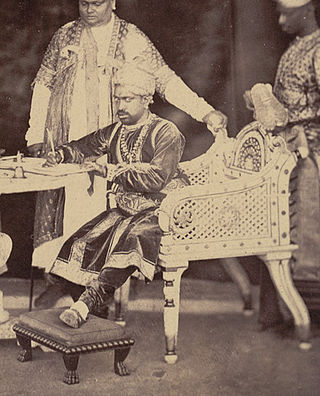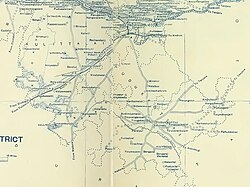
Pudukottai Municipal Corporation is the administrative headquarters of Pudukkottai district in the Indian state of Tamil Nadu. It is one of the oldest and Heritage city in India which contains a lot of histories. The city is also known as Thondaiman Pudukkottai. Pudukottai Municipal Corporation is located on the banks of the Vellar River. It has been ruled, at different times, by the Mutharaiyar dynasty, Cholas, Early Pandyas, Thondaimans, and the British. It is situated about 372 kilometres (231 mi) southwest of the state capital Chennai,50 kilometres (31 mi) southeast of Tiruchirappalli, 60 kilometres (37 mi) southwest of Thanjavur ,108 kilometres (67 mi) northeast of Madurai,116 kilometres (72 mi) East of Dindigul and 78 kilometres (48 mi) Northeast of Sivaganga. Tamil Nadu's first woman Asian Games competitor, Santhi Soundarajan, is from Pudukkottai.

Chola Nadu is an ancient region spanning on the current state of Tamil Nadu and union territory of Puducherry in southern India. It encompasses the lower reaches of the Kaveri River and its delta, and formed the cultural homeland and political base of the Chola Dynasty which ruled large parts of India and Sri Lanka between the 9th and 13th centuries CE. Uraiyur served as the early Chola capital, then medieval Cholas shifted to Thanjavur and later cholas king Rajendra Chola I moved the capital to Gangaikonda Cholapuram in Ariyalur district in the 11th century CE. Chola Nadu is therefore larger than the Tanjore region or the Cauvery delta in the strict sense. Although it essentially corresponds to these two overlapping areas.

Sir Amaravati Seshayya Sastri, or Sashiah Sastri, was an Indian administrator who served as the Diwan of Travancore from May 1872 to 4 May 1877 and as the Diwan of Pudukkottai from 1878 to 1894. He is credited with having modernized the city of Pudukkottai.

The Thondaman or Thondaiman was a dynasty ruled the region in and around Pudukkottai from the 17th to 20th century. The Pudukkottai Thondaiman dynasty was founded by Raghunatha Thondaiman, the brother-in-law of the then Raja of Ramnad, RaghunathaKilavan Setupati. The Pudukottai Samasthanam was under Thondaiman dynasty for one year even after Indian Independence. The Thondaiman dynasty had a special Valari regiment.

Raja Sri Brahdamba Dasa Raja Sri Rajagopala Tondaiman Bahadur was the ninth and last ruler of the princely state of Pudukkottai.

The Tondaiman family were Tamil rulers of the ancient Tondai Nadu (Tondaimandalam) division of Tamilakkam in South India. Their capital was at Kanchipuram.

The Kingdom of Ramnad or Ramnad estate was a permanently settled kingdom and later zamindari estate that existed in the Ramnad subdivision of the Madurai district and later Ramnad district of the erstwhile Madras Presidency in British India from 1601. It was ruled by the rajas also had the title of Sethupathi. Madurai Nayaks ruled the Ramnad area with the appointed chieftains between 14th to 16th century CE, and in 17th century CE the appointed governors expanded their power to establish "Ramnad Kingdom" which was also called as "Maravar Kingdom" by the British. In 1795 CE, after an heir dispute, they were reduced to the status of zamidari by the East India Company. After the independence of India in 1947 the estates were merged in the Union of India and in 1949 all rulers lost the ruling rights, privy purse was also finally abolished in 1971.

Raja Sri Brahdamba Dasa Raja Ramachandra Tondaiman Bahadur was the ruler of princely state of Pudukkottai from 13 July 1839 to 15 April 1886.
Raja Sri Raghunatha Tondaiman Bahadur was the ruler of the princely state of Pudukkottai from 4 June 1825 to 13 July 1839.
Vijaya Raghunatha Raya Tondaiman was the ruler of the princely state of Pudukkottai from 1 February 1807 to 4 June 1825.
Raja Sri Vijaya Raghunatha Tondaiman Bahadur was the ruler of the Pudukkottai kingdom from 30 December 1789 to 1 February 1807.
Raghunatha is a given name. Notable people with the name include:

The Madras Presidency was a province of British India comprising most of the present day Tamil Nadu and Andhra Pradesh along with a few districts and taluks of Karnataka, Kerala and Odisha. A few princely states, notably Ramnad and Pudukkottai also merged into the Presidency at some or the other time. The Presidency lasted till 1950, when it became the Madras State after India became a republic. In 1953, Telugu-speaking regions of the state split to form Andhra State. Subsequently, in 1956, Kannada- and Malayalam-speaking areas were merged with Mysore and Travancore-Cochin respectively.
The Trichinopoly district was a district of the erstwhile Madras Presidency of British India. It covered the present-day districts of Tiruchirappalli, Karur, Ariyalur and Perambalur in the Indian state of Tamil Nadu. The administrative headquarters was the town of Trichinopoly, Trichy or Tiruchi, now known as Tiruchirappalli. The district covered an area of 2,632 square miles (6,820 km2) in 1907. It was bound by the districts of South Arcot to the north, Salem to the west, Coimbatore to the west and north-west, Tanjore to the east and Madurai to the south. The princely state of Pudukkottai remained within the jurisdiction of Trichinopoly district from 1865 to 1947.

Thanjavur District was one of the districts in the erstwhile Madras Presidency of British India. It covered the area of the present-day districts of Thanjavur, Tiruvarur, Nagapattinam, Mayiladuthurai and Aranthangi taluk, Karambakkudi taluk of Pudukkottai District in Tamil Nadu. Apart from being a bedrock of Hindu orthodoxy, Tanjore was a centre of Chola cultural heritage and one of the richest and most prosperous districts in Madras Presidency.

Raja Sri Brahdamba Dasa Raja Sir Martanda Bhairava Tondaiman was the ruler of the princely state of Pudukkottai from 15 April 1886 to 28 May 1928.
Vijaya Raghunatha Pallavarayar Dorai Raja (1872–1930) was an Indian civil servant and administrator and a member of the royal house of Pudukkottai. He served as the Chief Minister of Pudukkottai state from 1909 to 1922 and regent from 1922 to 1929.
Vijaya Raghunatha Raya Tondaiman I was the second independent ruler of the Pudukkottai kingdom. He reigned from April 1730 to 28 December 1769. His reign was marked with incessant wars with the Thanjavur Maratha kingdom and against the French East India Company and Chanda Sahib.
Raja Sri Raghunatha Raya Tondaiman (1641–1730) was the ruler of the Pudukkottai kingdom from 1686 to 1730. A feudatory chieftain of the Sethupathi of Ramnad, in 1686, Raghunatha Raya Tondaiman was recognised as the independent ruler of Pudukkottai by the Sethupathi for the services he had rendered him.
Raya Rahutta Raya Vajridu Raya Mannida Raya Avadai Raghunatha Tondaiman was a Kallar chieftain of Karambakudi and a feudatory of the Vijayanagar Empire.

















